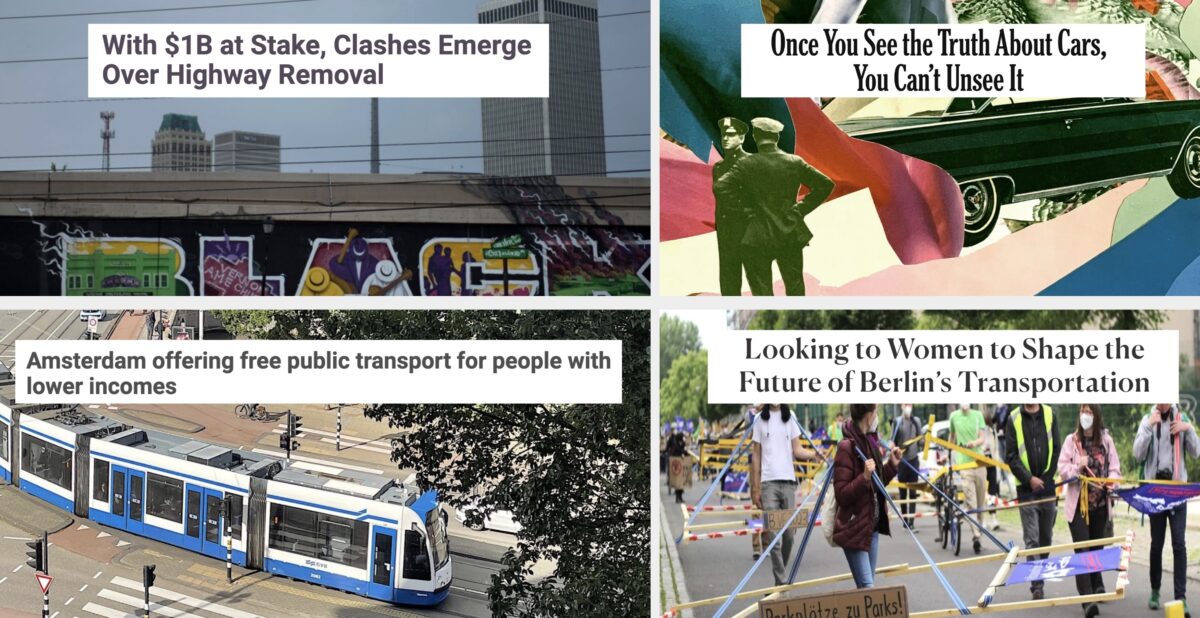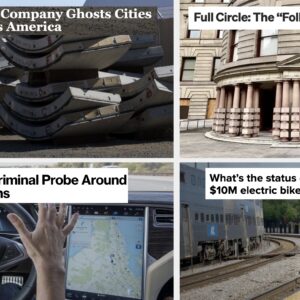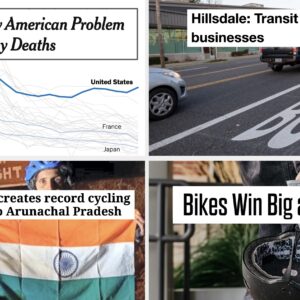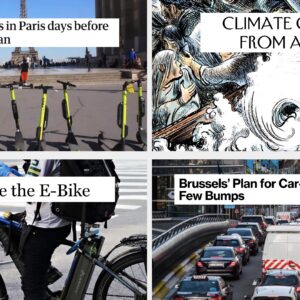Welcome to the week.
Today’s Monday Roundup is made possible by Action LED, where you can find high quality bike lights to keep riding through winter.
Here are the most notable stories our writers and readers came across in the past seven days…
The driving delusion: Cars aren’t freedom machines for everyone, especially those who have the most to lose when our system offers them no other choice. (NY Times Opinion)
Affordable mobility: Portugal has become the first country in the EU to take advantage of a policy that allows member nations to reduce taxes on the purchase of bicycles. (European Cyclists’ Federation)
Remove or remodel?: There’s growing tension between people who want to use the new federal “Reconnecting Communities” grant fund to remove highways or to simply add a bit of lipstick here and there (cough…. ODOT in Albina… cough). (Route Fifty)
Serious about public spaces: How can you tell when your city is moving from rhetoric to action on carfree places and other high quality public spaces? When they hire a full-time position to oversee the job like New York City is doing. (Streetsblog NYC)
Not Just Bikes: Amsterdam makes its transit highly accessible to, thanks in part to a new program that will give free fares to low-income riders. (NL Times)
Cars are not people: I am beside myself that the California Coastal Commission ruled that a bunch of restaurants near San Diego have to replace outdoor dining areas with car parking on absurd grounds like “privatizing public space” and “beach accessibility.” This is a backward, car-centric, anti-human planning decision that is a case study of transportation discrimination. (San Diego Union-Tribune)
A license for vigilantism: A few New York City activists are so fed up with people breaking parking laws by intentionally covering up their license plates they’ve started to fix the plates themselves. (NY Times)
Drivers behaving badly: A year-end survey from AAA shows how drivers know they are doing bad things but many of them admit to doing them anyways. (Auto Blog)
Gender and the carfree movement: Women are at the forefront of efforts to remove cars from Berlin roads and their fight illustrates how male-centric perspectives often dominates road design decisions. (Yes Magazine)
One-wheel, one mission: A teenager is cycling 3,000 miles on a unicycle from Maine to Florida to raise money and awareness for the East Coast Greenway path project. (The Guardian)
Thanks to everyone who shared links this week.







Thanks for reading.
BikePortland has served this community with independent community journalism since 2005. We rely on subscriptions from readers like you to survive. Your financial support is vital in keeping this valuable resource alive and well.
Please subscribe today to strengthen and expand our work.
Re: Removing highways and rebuilding communities, it’s interesting to see what is happening in Syracuse, New York. The $3.2B removal of a highway it was approved, but is now being held up by litigation.
https://www.enr.com/articles/55359-ny-court-halts-work-on-23b-syracuse-i-81-viaduct-removal
My community of Greensboro NC has applied for a Reconnecting Communities grant for the freeway that was forced through the black community in the 50s, to upgrade it to modern interstate standards, “because that is what the black community wants” according to local DOT officials and the richer blacks in town. It will not surprise anyone that no poll was ever taken and the very poor blacks along the corridor were never consulted. Same as it ever was.
That Route 50 post is excellent, and highlights a primary issue with basically every state DOT in the country – they still only really care about car throughput related metrics. Every dollar that gets put into an urban freeway is a dollar spent reinforcing the values and perspectives ingrained in the people who originally built it. Which for the vast majority of US urban freeways means serving richer whiter suburbanites (at the expense of generally more diverse city dwellers) and automotive interests.
Of course, no DOT is going to say that outright – but it’s something worth keeping in mind on every single freeway related project.
Comment of the week. I know a lot of readers probably already agree with this but I think it’s worth emphasizing the continuous historic and intellectual thread from the initial construction to present day maintenance. It’s politicians as well as DOTs that ignore this connection. It’s easy to say that we’ve grown beyond the racism and deurbanization of the previous era, but if our actions continue to be influenced by the same metrics and result in the same policies well… We haven’t really changed at all. The cognitive dissonance required to protect these freeways while disavowing the systems that put them in place is incredible, and needs to be pointed out.
Portland is 73% white
Beaverton is 69% white.
The suburbs have a lot more diversity in 2022 than the urban city does.
I live in wealthy white Portland.
You must not. It is not diverse by any means and has a higher average income than the “richer” suburbs as you put it.
You need to get out more.
I’m speaking generally about the country at large, not just the Portland Metro area. The entire Portland Metro area is very white by large US city standards (it’s the whitest city over 500,000 in the entire country), and the city of Portland is relatively white relative to most of it’s larger suburban satellites. But it’s also just not as simple as you are making it seem here.
Here is a list of Portland and suburbs by “white alone” population % (“white alone” is a different measure than “white”, since white generally includes some portion Hispanic/Latino + white as well). I think this list includes every city (or census designated place) with population > 10,000 served by TriMet or CTRAN.
Notable here, basically every city in the region more diverse than Portland is either a major economic hub in its own right (Beaverton, Hillsboro, Gresham), strongly associated with agriculture (Cornelius), or Fairview (lots of jobs in Fairview, but I’m not overly familiar with it). Notably, Beaverton – Hillsboro – Gresham are also the best transit served suburbs. The whitest cities on this list are some of the most freeway focused places in the region; the places where people are most reliant on cars, freeways, and other automobile infrastructure.
It’s not as simple in terms of income, but considering Portland has much lower rates of car ownership than all of its suburbs it’s still fair to say that every freeway project has a disproportionate impact of serving suburban commuters at the expense of city people. A freeway project that expands a bridge between West Linn and Oregon City serves a whiter (and likely richer) clientele – money that could be spent on improving safety and transit on say TV Highway, Powell Boulevard or 82nd Ave – historically disinvested facilities that are in more diverse and lower income areas of the region.
Keep in mind that mixed in with the “whites” are recent immigrants, migrant workers and refugees from Ukraine, Russia, Romania, Afghanistan, Iraq, Syria, and the European crew at Adidas and Freightliner. How do your numbers handle white Latinx?
Is the assertion that non-car owners in Portland subsidize projects that benefit suburban car owners? If so, how?
No, I’m not attempting to make that argument (although I do find it compelling).
I’m saying that ODOT spends money expanding freeways when more critical safety investments are desperately needed on so-called “orphaned” urban facilities (the TV Highways of the world), and that this makes it extremely difficult to trust ODOT when they spout about how much they care about safety and equity. I don’t really have the data to back up who subsidizes who so I won’t speak on it directly.
It shouldn’t be, because they don’t. Road projects in Oregon are paid for by user fees and gas taxes, so if urban residents are paying more for roads, it’s only because they use the roads more, which they probably don’t.
There is a long tradition of using “sin” taxes to pay for things that better society as a whole. The only problem with fossil fuel “sin” taxes is that they are so low that they have a negligible impact on the sin itself.
You know that I have no problem with increasing the gas tax, which I see as a poor substitute for a carbon tax.
That said, I don’t think many Americans see gasoline as a “sin” the way they might alcohol and cigarettes, so I don’t know if the sin tax framing would be effective politically.
One tidbit about using the census on race is that replies are self-selective, of how often respondents will not put down their predominant “race” or the way others see them, but will put down either mixed or some other race, that they resent the race question being asked at all. I know many people who “look white” who answer on the census “African-American”, “Indian”, “Latino”, and so on. Given the high rate of violent extra-marital relationships between slaves and overseers and owners, it’s a rare African-American who doesn’t have at least one “white” ancestor somewhere along the way and I’ve met many African-Americans who answer “white” on the forms. And how does the census handle people who don’t respond at all? Yup, they call them “white”.
Race really is in the eye of the beholder.
Gresham is not a major economic hub but is a suburb that increasingly attracts residents who were priced out of E Portland. It’s this dynamic, which as Watts notes is increasingly common in the USA, that makes the indiscriminate suburb-hate of some urbanists kind of racist and classist.
I think that Happy Valley one is suspect.
2021 stats show it is 22% Asian, 4.5% latino.
So it is at most 74% white only.
DWK- I don’t think these statistics negate the historical argument we’re making here regarding the construction and maintenance of freeways, especially when it’s pretty easy to argue that the construction of these freeways caused the effect you’re talking about especially w/r/t black Portlanders in inner NE. Without construction of I-5, Emmanuel, or Memorial Coliseum (and maybe with some equal access to mortgages and capital) it’s not hard to envision a stronger hub for black culture and business than exists today despite what has been done. That would be good for all of Portland, not just for all the people that were displaced. It’s not hard for many to see decommissioning as a step that would right historical wrongs if done properly, whatever properly means.
I don’t think statistics negate the argument but if you want to go there, I’ll throw some more your way and connect them to the I-5 corridor map in a way that refutes or at least contextualizes what you’re arguing here. Keep in mind, I do currently live in Portland (73% white) but I grew up in Canby (77%) which used to be a pretty ag heavy place but is increasingly a bedroom suburb for Portland. Let’s run through the other communities I grew up in and around that are all pretty similar, and that actually use I-5 regularly for work and play: Wilsonville (76%) Oregon City (88%) Tualatin (73%) Sherwood (83%) Tigard (79%) West Linn (87%) Lake Oswego (80%). I won’t even get into the Washington side suburbs, because I don’t know as much about them. These places have pretty uniformly seen rounds of explosive growth in the last several decades. Canby is the furthest out among these towns listed and even it has seen its population double in the last thirty years, thousands of acres of land transformed from agriculture to suburb, and home prices double in the last five and >10x in the last 30 years. The closer in you get the more dramatic these numbers are. It’s very hard for me to imagine this would happen at this scale without I-5. This means that a group of towns whiter than Portland were given effectively free growth tickets that must be on the order of hundreds of millions if not billions of dollars by now. At what cost? The destruction of a neighborhood that by some measures housed 80% of Portland’s black population at the time.
As we continue to pour billions of dollars into freeway maintenance and expansion we are directly reinforcing the history that led to this piece of infrastructure and we subsidize growth in these towns that I grow up in. Was/is it worth it to harm the community in order to further suburbanize all of these towns? I don’t think so, even having directly benefited from this process.
In sum, I’d encourage you to get out to Canby and these other suburbs a little more. Canby has a cute little downtown that’s super walkable, with a couple neat antique shops, a lego store ( Bricks n Minifigs world headquarters!) a tasty sandwich shop, a movie theater, and one of my favorite bike shops in the region. If you go, I hope your perception of the suburbs becomes a little more nuanced.
Oh, and a final note. It’s usually better to look at the median incomes rather than the average. 50% of people make more and 50% of people make less than that number. I think you will find that Portland is a lot less rich than you thought. Maybe you should get out of your socioeconomic circles, too. https://ktvz.com/stacker-oregon/2021/12/15/highest-earning-cities-in-oregon/
You listed Portland and Beaverton. Why aren’t you listing the rest of the suburbs? Perhaps because it doesn’t fit your narrative?
I did not have a narrative… i was just pointing out that people in Portland are always talking diversity and we had 6 months of riots over black lives matter and this is the whitest damn city in the country.
It’s tiring reading the “narrative” here that this is a diverse city when it is not.
Portland is diverse; just not racially or politically.
In many cities, the suburbs are quite diverse, and often not particularly rich, while the inner cores have become more of both (gentrified by people like you and me). Your stereotypes are outdated.
Okay, which cities? What American cities suburbs are, on the whole, more diverse than the city proper? I’d guess very expensive, poly-centric places like the Bay Area might be – but it’s still probably be a mixed bag and dependent on what you consider to be a suburb. And still, Oakland and San Francisco are much more diverse than Livermore, Palo Alto, and Martinez – both in terms of racial statistics and income (there are a higher proportion of people living on less than $10,000/year in San Francisco and Oakland than in those three suburbs).
Every city has rich areas, poor areas, rich suburbs, and working class suburbs. But by and large, most US cities have suburbs that are still oriented towards buying a house and driving a car – two things that are either prohibitively expensive (buying a house) or just regular expensive (driving a car). Sure, suburbs can be more diverse and less well off than but I’d hardly say that it’s typical.
https://www.brookings.edu/research/todays-suburbs-are-symbolic-of-americas-rising-diversity-a-2020-census-portrait/
From the AAA article.
Meaning what 25-30% were actually too impaired? If that’s the self-reported amount you know the actual has to be significantly higher. Drunk people aren’t the best at making good judgements.
I’ll be referencing this the next time someone says we need enforcement or any of the changes PBOT does are pointless. I still think enforcement is important but it appears to have little effect on behavior. Perhaps if we moved to a point based system people would be more inclined to drive safely. Although for some people losing a license wouldn’t change anything why we don’t confiscate more cars is beyond me.
That’s a bit of circular reasoning. The fact that enforcement is weak is the reason the possibility of being caught has little impact on drivers’ decision-making. I.e., there is little possibility of being caught, so it’s not really a factor. Same thing goes for speeding and running red lights, etc etc.
This isn’t a survey of just people in Portland it’s nationwide. They do actually pull people over and ticket them in other cities sometimes too much. So it would appear that even if there is a reasonable chance they could be ticketed people still break the laws. Similar reasoning to harsher sentences not reducing crime because criminals aren’t thinking of the consequences.
No matter where you live, the chances of getting caught in a traffic infraction by a cop is minimal.
Long before the current blue flu in PDX most people already got away with driving drunk, speeding and other dangerous behaviors.
That “only” really stood out to me, because it sounds like AAA is thinking that having 7.3% percent of people admitting to driving drunk is a GOOD thing. It really should have said, “A whopping (or “disturbing” or “troubling”) 7.3%…”.
And that’s even without factoring in what you mention about it certainly being underreported, given that it’s illegal and dangerous.
The long term arc of history at the California Coastal Commission (Gov. Brown’s evolution of support, Prop 20 etc.) is an interesting planners’ case study of the public solving one problem but creating a new one etc. As a planner, I have only ever had one project that overlapped with the California Coastal Commission overlay…lucky for us we were creating more “parking” for improving public access to the beach by building a mini-Bikestation on existing asphalt at a transit hub…I hate to think if they had flagged it for denial for swapping two car stalls for 20 bike stalls.
“Its mission as defined in the California Coastal Act is “to protect, conserve, restore, and enhance the environment of the California coastline”.[2][3] – Wikipedia